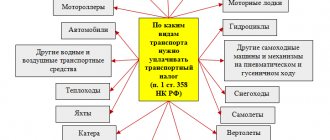What is transport tax?
Transport tax is a tax levied on vehicle owners. Transport means are: cars, motorcycles, scooters, buses, airplanes, helicopters, motor ships, yachts, sailing ships, boats, snowmobiles, motor sleighs, jet skis, motor boats and other water and air vehicles.
Not all vehicles are subject to taxation. For example, the following exceptions exist: - rowing boats, as well as motor boats with an engine power of no more than 5 horsepower - vehicles that are wanted, subject to confirmation of the fact of their theft (theft) by a document issued by an authorized body. The full list of exceptions is indicated in Article 358 of the Tax Code of the Russian Federation.
Payers of transport tax are both individuals and legal entities.
Vehicle specifications
The technical characteristics that are necessary to determine the tax rate are:
- engine power in horsepower - for vehicles with engines;
- gross tonnage in registered tons - for non-self-propelled (towed) water vehicles;
- vehicle unit – for other water and air vehicles.
This follows from Article 361 of the Tax Code of the Russian Federation.
Situation: how to determine the technical characteristics of a vehicle (power, gross tonnage) to determine the transport tax rate?
Determine engine power or gross capacity using the data specified in the technical documentation. For example, in the vehicle passport (PTS) (clauses 18 and 21 of the Methodological Recommendations, approved by order of the Ministry of Taxes and Taxes of Russia dated April 9, 2003 No. BG-3-21/177).
If the data specified by the inspectorate in the tax notice differs from the data in the technical documentation, then the data from the technical documentation must be used to calculate the tax.
If the technical documentation does not contain data on engine power (gross capacity), then an expert opinion can be used to determine the rate and calculate the tax. This is stated in paragraph 22 of the Methodological Recommendations, approved by order of the Ministry of Taxes and Taxes of Russia dated April 9, 2003 No. BG-3-21/177.
If the vehicle power is indicated in kW, it must be converted to horsepower.
Situation: how to determine the power of a vehicle to determine the transport tax rate, if in the technical documentation of the vehicle the engine power is indicated in kW?
To calculate the tax base for transport tax, engine power must be expressed in horsepower (subclause 1, clause 1, article 359 of the Tax Code of the Russian Federation). If in the technical documentation this indicator is expressed in kW, it must be recalculated using the formula:
| Engine power expressed in hp. With. = Engine power expressed in kW × 1.35962 |
Round the result obtained according to the rules of arithmetic to the second decimal place. This procedure is provided for in paragraph 19 of the Methodological Recommendations, approved by order of the Ministry of Taxes and Taxes of Russia dated April 9, 2003 No. BG-3-21/177.
An example of vehicle power conversion. In the PTS, the engine power is indicated in kW
The engine power of the Lada Kalina Universal 1.6 passenger car is 58.9 kW. This corresponds to the power: 58.9 kW × 1.35962 = 80.08 liters. With.
How to calculate the tax amount?
The amount of transport tax is calculated based on the following parameters: — Tax rate
The tax rate is established by the laws of the constituent entities of the Russian Federation per one horsepower of engine power.
Depends on power, gross capacity, vehicle category and year of manufacture of the vehicle. Tax rates can be increased or decreased by the laws of the constituent entities of the Russian Federation by no more than 10 times the rate specified in the Tax Code of the Russian Federation. — Tax base
This parameter is set depending on the type of vehicle.
For cars, motorcycles and other vehicles with an engine, this is the engine power in horsepower - Ownership period
The number of complete months of ownership of the vehicle during the year.
— Increasing coefficient
For passenger cars with an average cost of 3 million rubles. a multiplying factor is applied. The list of such cars is available on the website of the Ministry of Industry and Trade of the Russian Federation.
How are transport tax rates applied in Moscow for 2020?
The vehicle tax rate is a typical component of the formula for calculating it, along with the tax base (generally represented by engine power). The tax rate can be:
- federal - applied in the quantities reflected in clause 1 of Art. 361 Tax Code of the Russian Federation;
- regional - established by a regulatory act of a constituent entity of the Russian Federation in an amount that can be increased or decreased by no more than 10 times compared to federal values (clause 2 of Article 361 of the Tax Code of the Russian Federation).
Moreover, if the taxable vehicle is a passenger car with a capacity of no more than 150 HP, then the region has the right to reduce rates without limitation.
If the region does not have its own rates, then federal rates are applied.
The law of the region may also establish vehicle tax benefits. As a rule, they are established by the same regulation that approves tax rates. In the Russian capital, this is Moscow Law No. “On Transport Tax” dated 07/09/2008 (as amended on 11/20/2019).
In some cases, knowledge of these two components of the tax calculation formula - the rate (federal, regional) and the taxable base is not enough. The fact is that for expensive cars with an average market price of 3 million rubles and above, another indicator is used - an increasing coefficient. Its size, tied to various price intervals and service life of the machine, is determined in paragraph 2 of Art. 362 Tax Code of the Russian Federation.
When calculating the payment for an expensive car that falls under the criteria reflected in clause 2 of Art. 362 of the Tax Code of the Russian Federation, the transport tax rate in Moscow in 2021, together with the tax base, is thus multiplied by an increasing factor.
Legal entity taxpayers carry out the calculation of vehicle tax using federal or regional rates, the base, and, if necessary, an increasing coefficient independently. In 2021, the Federal Tax Service will send special information notices to such persons to verify the amount of tax (letter of the Federal Tax Service of Russia dated June 19, 2019 No. 03-05-05-02/44672). But this does not cancel the payer’s obligation to calculate it.
Starting from the 2021 tax period, companies do not need to submit a transport tax return (Law No. 63-FZ dated April 15, 2019). But for earlier periods it may be necessary to provide an updated report. The declaration records, in particular (in Section 2):
- tax rate (line 170);
- benefit (lines 200-270).
If a benefit in the form of a complete tax exemption was applied, the rate is still reflected. If an error is discovered in the declaration that affects the calculation of the tax amount (including the rate), you must submit an “adjustment”.
Who is entitled to transport tax benefits?
At the federal level, the following categories of citizens are exempt from paying transport tax:
- Heroes of the Soviet Union, heroes of the Russian Federation, citizens awarded Orders of Glory of three degrees - for one vehicle;
- veterans of the Great Patriotic War, disabled people of the Great Patriotic War - for one vehicle;
- combat veterans, disabled combat veterans - for one vehicle;
- disabled people of groups I and II - for one vehicle;
- former minor prisoners of concentration camps, ghettos, and other places of forced detention created by the Nazis and their allies during the Second World War - for one vehicle;
- one of the parents (adoptive parents), guardian, trustee of a disabled child - for one vehicle;
- owners of passenger cars with an engine power of up to 70 horsepower (up to 51.49 kilowatts) inclusive - for one such vehicle;
- one of the parents (adoptive parents) in a large family - for one vehicle;
- owners of vehicles belonging to other preferential categories.
In addition to the federal list of preferential categories of citizens, there are regional benefits. For example, in some regions of the Russian Federation, pensioners pay only 50% of transport tax, or are completely exempt from it. The situation varies greatly depending on the region. For example, in Moscow there are no benefits for pensioners, and in St. Petersburg pensioners are completely exempt from paying transport tax for a domestically produced car with an engine power of up to 150 horsepower.
You can find out the availability of regional benefits on the tax service website, in the “electronic services” section. On this page you must select a subject of the Russian Federation, municipality (city), type of tax and year. After this, you will receive complete information about all types of transport tax benefits for individuals.
It is important to know that the tax authority does not have the right to provide a transport tax benefit based solely on age information. Benefits are of a declarative nature, as a result of which it is necessary to submit to the Federal Tax Service the taxpayer’s application in the prescribed form, which indicates the basis for providing the benefit (reaching retirement age).
Procedure for paying tax payments
A notification from the tax authority about the amount of assessments is given to the citizen-taxpayer before the first of June of the current period inclusive. Most often, the notification is sent only to the personal account without notifying the individual by mail. If a vehicle is registered or deregistered after this date in a specific tax period, the relevant registration authorities, within thirty days, send the citizen-taxpayer a notice of recalculation of the financial obligation to pay the mandatory annual transport payment.
Categories of preferential taxpayers
According to the provisions of the law on transport tax of the city of Moscow, the group of tax beneficiaries includes the following categories of citizens and organizations:
- Companies that transport passengers through urban passenger transport intended for public use (not taxis).
- Payers of transport tax are legal entities of Moscow included in the list of residents of the special economic technology-innovation zone "Zelenograd". The benefits apply to vehicles registered after companies have been added to the relevant register. The fee waiver is valid for five years from the month in which the specific vehicle was registered. To receive the benefit, you must provide an extract from the relevant register. The document is issued by the body responsible for managing this economic sector.
- Heroes of the USSR or Russia, holders of the Order of Glory of all three degrees (for one vehicle registered to the specified citizen).
- Payers of transport tax in Moscow are disabled people and veterans of the Second World War (for one car).
- Veterans or disabled military personnel for one vehicle.
- Payers of transport tax in Moscow are individuals with a disability of the first or second group (for one car).
- Former prisoners of fascist ghettos, concentration camps or other places of detention of minors for one means of transportation.
- Parent, guardian or guardian of a disabled minor (per car).
- Citizens who own passenger cars with an engine no more powerful than 70 horsepower (for one vehicle).
- Payers of transport tax in Moscow are large families (for one car).
- Citizens who are entitled to social financial support under the provisions of Law No. 1244-1, which regulates the social protection of persons exposed to radiation in connection with the Chernobyl disaster and other incidents related to radiation (per car).
- Citizens who took part as part of special risk units in testing thermonuclear and nuclear weapons, as well as in eliminating the consequences of accidents when they were installed in weapons and military-type facilities (for one vehicle).
- Payers of transport tax in Moscow are disabled due to radiation sickness or nuclear weapons testing, as well as due to other work related to nuclear installations and space technology (for one car).
How to calculate the number of complete months of car ownership?
If a vehicle is delivered or deregistered during the year, then the transport tax is calculated with a certain coefficient. This coefficient is defined as the ratio of the number of complete months during which a given vehicle was registered to the number of calendar months in a year (12).
The procedure for determining the number of full months of car ownership is calculated in accordance with paragraph 3 of Art. 362 of the Tax Code of the Russian Federation. Month of registration
It is considered complete if the vehicle
is registered
before the 15th day inclusive.
The month of deregistration is considered complete if the car is deregistered
after the 15th day. For example, if a car was registered after the 15th, then this month is not complete and is not taken into account when calculating the car tax.
What determines the bet size?
The transport tax rate depends on:
- vehicle categories;
- technical characteristics of the vehicle;
- the number of years that have passed since the vehicle was manufactured and (or) its environmental class.
This follows from paragraphs 1 and 3 of Article 361 of the Tax Code of the Russian Federation.
To find out your tax rate, determine all these indicators for your vehicle. Then select from the list of rates established in the subject of the Russian Federation where the car is registered, the one that meets all these characteristics.
Advice : to find transport tax rates and benefits that apply in the constituent entity of the Russian Federation where the car is registered, refer to regional legislation. To do this, go to the official website of the Federal Tax Service of Russia in the “Property taxes: rates and benefits” service.
The rate at which the inspectorate calculates a person’s tax is indicated in the tax notice (annex to the order of the Federal Tax Service of Russia dated October 5, 2010 No. ММВ-7-11/479).
Transport tax for legal entities in Moscow
Legal entities calculate the amount of tax for the transport they use themselves. In addition, they are assigned the obligation to fill out a tax return and enter data on the transfer of transport tax into the accounting registers. If an error is discovered in a tax return that has already been submitted, the organization is obliged to recalculate the amount payable and submit an updated return, in which case it will most likely be able to avoid consequences.
From July 3, 2021 it became possible to reduce the amount of this tax on heavy trucks for 2016-2021. on the amount of funds transferred to the budget to compensate for damage caused to the road surface.
Organizations pay transport tax based on information from accounting registers. Moscow companies do not make advance payments throughout the year, and the transport tax itself is paid to the Moscow city budget once a year. Legal entities submit reports at the same time they make tax payments - no later than February 5 of the year following the reporting period. In case of transfer of too large an amount, the tax authorities, at the choice of the taxpayer company, will either offset the amount against future transport tax payments or return the excess money to the bank account.








